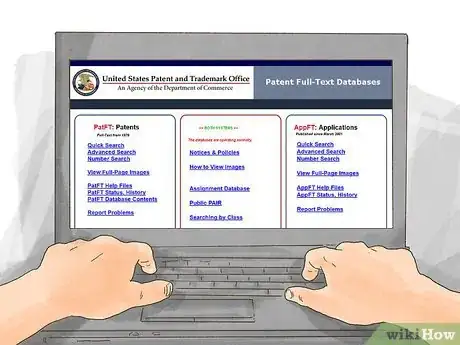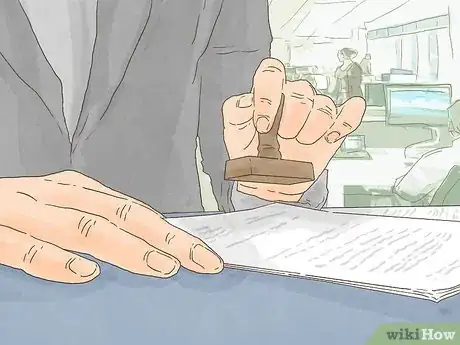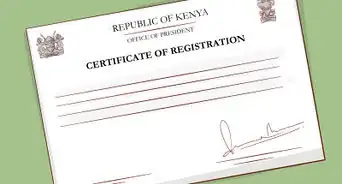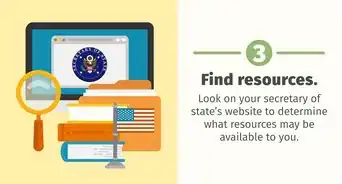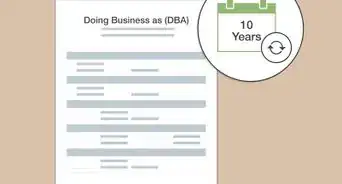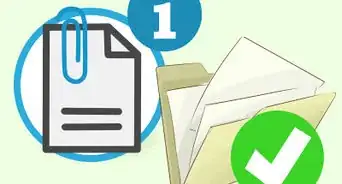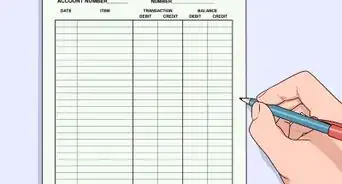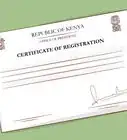This article was co-authored by Madison Boehm. Madison Boehm is a Business Advisor and the Co-Founder of Jaxson Maximus, a men’s salon and custom clothiers based in southern Florida. She specializes in business development, operations, and finance. Additionally, she has experience in the salon, clothing, and retail sectors. Madison holds a BBA in Entrepreneurship and Marketing from The University of Houston.
There are 13 references cited in this article, which can be found at the bottom of the page.
wikiHow marks an article as reader-approved once it receives enough positive feedback. In this case, 93% of readers who voted found the article helpful, earning it our reader-approved status.
This article has been viewed 88,480 times.
A sole proprietorship is the easiest type of business to set up. Unlike corporations or limited liability companies, you don’t have to file with your state. Instead, you'll pick a business name and register it. Then, depending on your city and county, you might need to obtain permits and licenses in order to operate. We'll walk you through everything you need to know from registering your name to creating a business plan so you can get your sole proprietorship up and running.
Steps
Choosing a Name
-
1Pick a memorable name. You can choose to operate your business under your legal name. For example, if Andrea Smith is a freelance photographer, she can work under her name “Andrea Smith.” However, you might find it beneficial to come up with a name. You can choose a name that is unique and has some significance.[1]
- For example, Andrea Smith might name her company “Wedding Wishes” if she specializes in wedding photography.
- Think of words that are associated with your business. For example, a massage is relaxing and therapeutic. Accordingly, a good business name might be “Touch Therapy.” Pick a name that matches your brand so that clients can discover you more easily.[2]
-
2Check that your name is available. You can’t use a business name if someone else in your state is also using it. Check with your state’s database of business names, which you can find at the Secretary of State’s website.Advertisement
-
3File for a fictitious business name. Any name that isn’t your legal name is a “fictitious name,” also called a “doing business as” (DBA). You should register your DBA with your county or state.[5]
- The process will differ depending on where you live. For example, in some places, you’ll need to publish your fictitious name in the newspaper to give the public notice.
-
4Confirm the URL is available. Most businesses have websites, so you’ll want the URL to be the same as your business name.[6] Check to see if it has been taken at the register.com website.
- Reserve the name by registering it, even if you aren’t prepared to create a website immediately.
Satisfying Legal Requirements
-
1Register with your city or county. Contact your local government and report that you have opened a business. You will probably have to complete paperwork and possibly pay a fee.[7]
-
2Obtain other required permits or licenses. You can check with your nearest Small Business Development Center to see if you need other permits or licenses.[8] Find your nearest SBDC here: https://www.sba.gov/tools/local-assistance/sbdc. Click on your state.
- For example, you might need a health department permit if you prepare food as part of your business.[9]
- Some businesses also need federal licenses. For example, if you are involved in the transportation or importation of animals, you may need a license from the U.S. Department of Agriculture.[10] The SBDC can help you identify required licenses.
-
3Register with your state’s taxing authority. You’ll need to register if you have employees or if you collect sales tax. Contact your state’s Department of Revenue or equivalent office and complete required paperwork.
-
4Check zoning. If you work out of your home, then check that it is legal to do so. You might need a zoning permit from your local board.[11] Stop into the office and ask.
Taking Next Steps
-
1Obtain an Employer Identification Number (EIN). Generally, you’ll need this number if you intend to hire employees or if you want to set up a retirement plan. If you don’t, you can use your Social Security Number.[12]
- Visit https://www.irs.gov/businesses/small-businesses-self-employed/apply-for-an-employer-identification-number-ein-online to apply for your EIN.
-
2Open business bank accounts. You can open a business checking or savings account at almost any bank. Take your tax ID number, DBA certificate, and a copy of any business licenses.[13]
- Remember to keep your business and personal finances separate. To this end, you might want to open your business accounts at a different bank than the one you use for your personal finances.
-
3Get insurance. As the owner of a sole proprietorship, you are personally responsible for your business’ legal obligations. For example, you can be held personally responsible if your business owes money or if it injures someone.[14] To protect yourself, you should seek insurance.
- If you use your car, then make sure your automobile insurance covers your business use.
- Obtain property and liability insurance if people are visiting your home. Your homeowner’s policy might not cover business injuries.
- There may be other insurance specific to your profession. For example, writers can get media liability insurance.[15]
-
4Write a business plan. Your business plan is a roadmap of where the business will be in the next few years. You don’t have to write a business plan, but it is helpful. Also, if you ever want a business loan, then a lender will want to see the plan. A thorough business plan should contain the following:[16]
- Business description. In this section, identify your business’ purpose. For example, you might be dedicated to bringing massage therapy to rural Wisconsin. Also provide an overview of your products and services.
- Market analysis. Describe your industry: its size and health, as well as any trends. Also identify your target market. Create a typical consumer profile in terms of location, age, gender, income, and education.
- Competitive assessment. Identify businesses you will be competing with, whether local or global. Critically analyze them and explain their weaknesses and strengths.
- Marketing plan. Go into greater detail about your products or services. Identify any problems you need to address. As part of your marketing plan, discuss the costs of providing your service or product and build a pricing strategy around those costs. Finally, discuss your promotion efforts, which can include paid advertising or social media.
- Operating plan. List who will manage the business (other than yourself) and identify what resources you need to run your business.
- Financial plan. Create current financial statements and estimate your income, cash flows, and balance sheet for the next two to four years. If you need financing, then calculate the amount you need as well as the type (e.g., a small business loan).
-
5Hire professional help. Small businesses benefit from professional assistance at various points. You should start early to find experienced professionals, such as the following:
- Business lawyer. A business lawyer can answer any legal questions you have and advise you about how to hire employees the right way. If you need to negotiate a contract, then a lawyer is helpful as well.[17]
- Accountant. An accountant helps at tax time, but they can also help you draft your business plan and offer advice about when it’s time to transition your sole proprietorship to an LLC or other form.[18]
- Bookkeeper. A bookkeeper records your daily business transactions. You can use software at first, but your business might grow large enough that you need to hire someone.
-
6File necessary taxes. As a sole proprietor, you will have many tax obligations. For example, you may have to file and pay any of the following taxes:[19]
- Income taxes
- Self-employment tax
- Estimated tax
- Withholding taxes for employees
- Federal unemployment tax
- Excise taxes
Community Q&A
-
QuestionAre taxes required if I am the sole employee?
 Community AnswerYes. You will have to file a 1040 and Schedule C (profit or loss from business).
Community AnswerYes. You will have to file a 1040 and Schedule C (profit or loss from business).
References
- ↑ Madison Boehm. Business Advisor, Jaxson Maximus. Expert Interview. 29 September 2021.
- ↑ Madison Boehm. Business Advisor, Jaxson Maximus. Expert Interview. 29 September 2021.
- ↑ Madison Boehm. Business Advisor, Jaxson Maximus. Expert Interview. 29 September 2021.
- ↑ http://tmsearch.uspto.gov/bin/gate.exe?f=tess&state=4801:k9r0vn.1.1
- ↑ https://www.inc.com/guides/2010/10/how-to-start-a-sole-proprietorship.html
- ↑ https://www.inc.com/guides/2010/10/how-to-start-a-sole-proprietorship.html
- ↑ http://smallbusiness.findlaw.com/incorporation-and-legal-structures/how-to-set-up-a-sole-proprietorship.html
- ↑ https://www.inc.com/guides/2010/10/how-to-start-a-sole-proprietorship.html
- ↑ http://smallbusiness.findlaw.com/starting-a-business/starting-a-business-license-and-permit-checklist.html
- ↑ https://www.sba.gov/starting-business/business-licenses-permits/federal-licenses-permits
- ↑ http://smallbusiness.findlaw.com/incorporation-and-legal-structures/how-to-set-up-a-sole-proprietorship.html
- ↑ http://www.nolo.com/legal-encyclopedia/when-does-sole-proprietor-need-ein.html
- ↑ http://www.nolo.com/legal-encyclopedia/opening-business-bank-account.html
- ↑ https://www.inc.com/guides/2010/10/how-to-start-a-sole-proprietorship.html
- ↑ https://www.authorsguild.org/member-services/media-liability-insurance/
- ↑ https://www.extension.purdue.edu/extmedia/ec/ec-735.pdf
- ↑ http://smallbusiness.findlaw.com/business-lawyer-resources/when-do-i-need-a-business-lawyer-for-my-small-business.html
- ↑ https://www.xero.com/us/small-business-guides/accounting/when-to-hire-accountant/
- ↑ https://www.irs.gov/businesses/small-businesses-self-employed/sole-proprietorships


